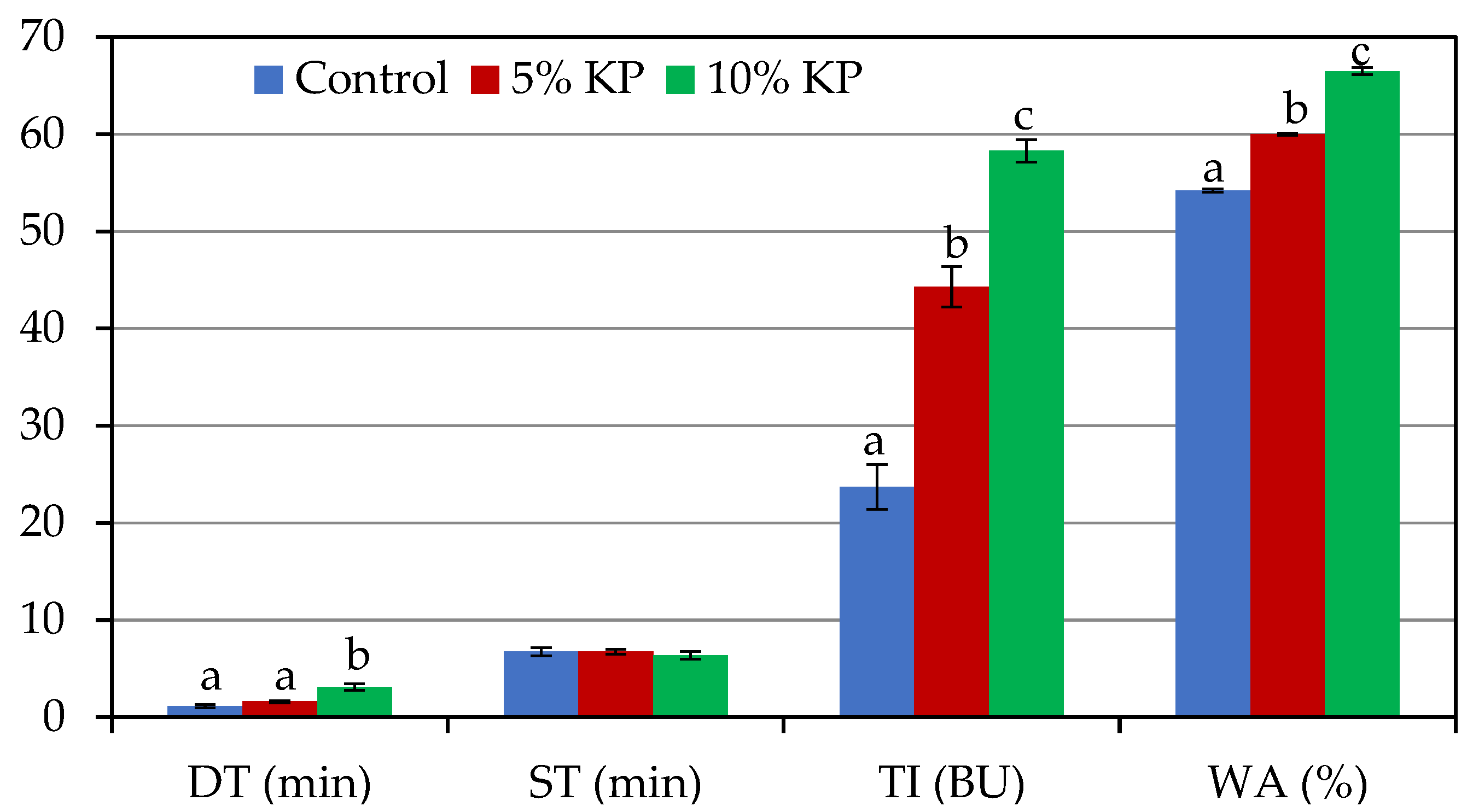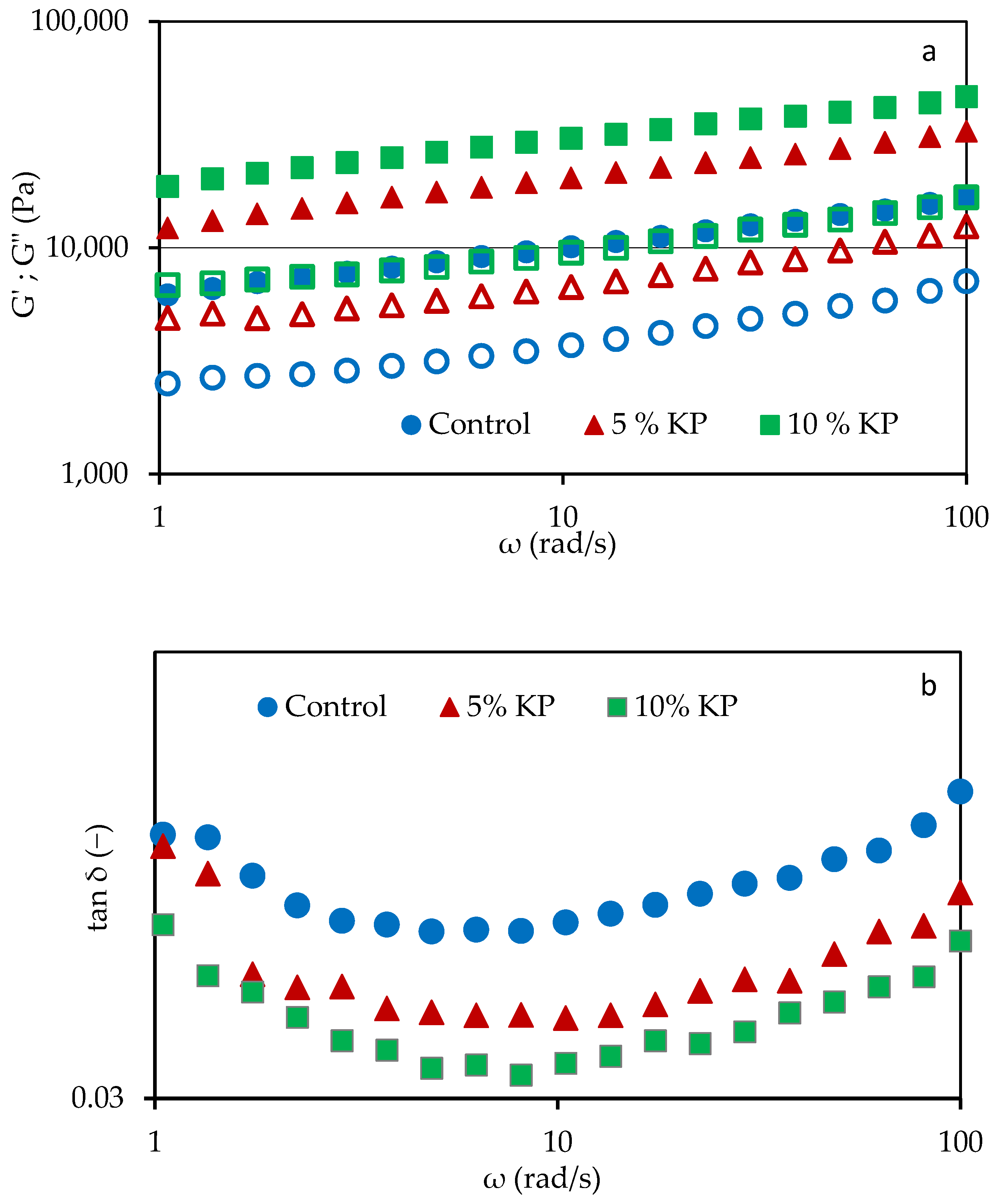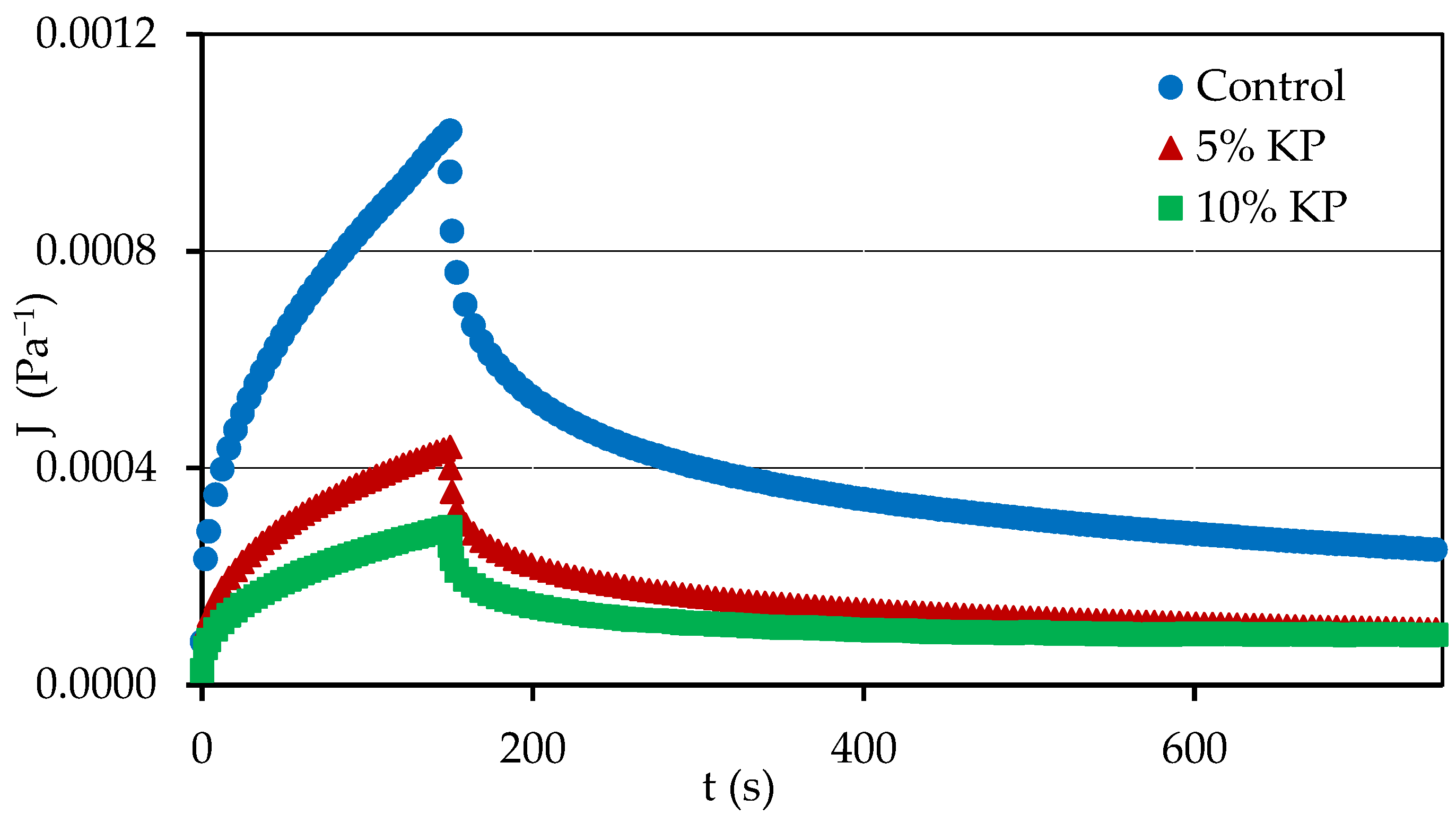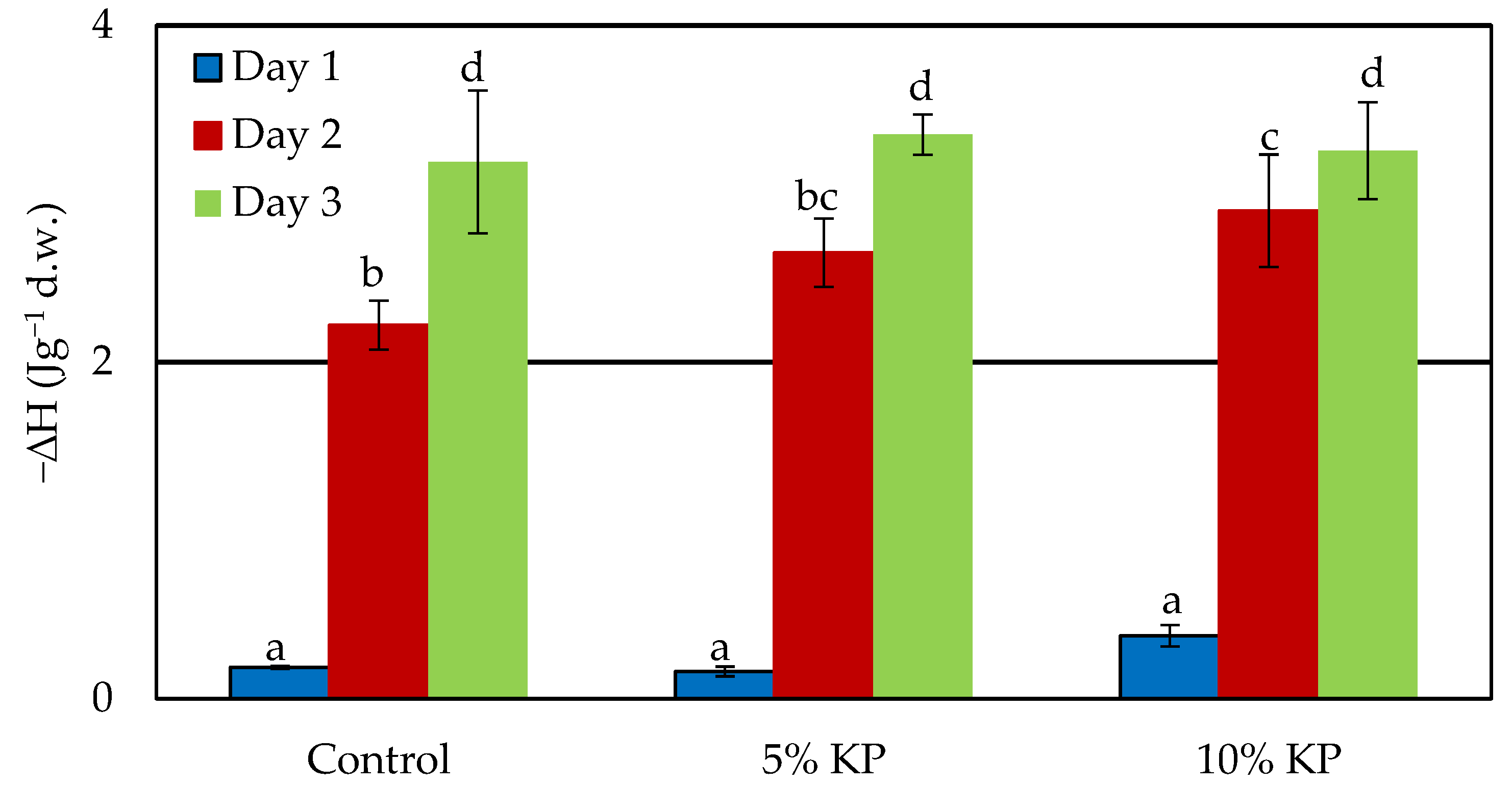Dough Rheological Properties and Characteristics of Wheat Bread with the Addition of Lyophilized Kale (Brassica oleracea L. var. sabellica) Powder
Abstract
1. Introduction
2. Materials and Methods
2.1. Materials
2.2. Dough and Bread Making
2.3. Dough Rheological Tests
2.4. Evaluation of Composition and Physical Properties of Bread
2.5. Bread Crumb Color and the Content of Pigments
2.6. Sensory Test of Bread
2.7. Texture Test of Bread
2.8. Thermal Evaluation of Bread
2.9. Statistical Analysis
3. Results and Discussion
3.1. Dough Rheological Tests
3.2. Composition and Physical Properties of Bread
3.3. Bread Acceptability
3.4. Bread Texture
3.5. Thermal Properties of the Crumb
4. Conclusions
Author Contributions
Funding
Institutional Review Board Statement
Informed Consent Statement
Data Availability Statement
Conflicts of Interest
References
- Khoozani, A.A.; Kebede, B.; Bekhit, A.E.-D.A. The effects of green banana flour fortification on volatiles compounds of bread: A fingerprinting approach. Appl. Food Res. 2022, 2, 100202. [Google Scholar] [CrossRef]
- Pycia, K.; Kapusta, I. Effect of hazelnut and walnut maturity stage and of amount of their additive on physicochemical and antioxidant properties of enriched wheat bread. Food Sci. Techn. Qual. 2020, 123, 62–81. [Google Scholar] [CrossRef]
- Fraś, A.; Gołębiewska, K.; Wiśniewska, M.; Mańkowski, D.R. Assessing content of selected nutrients and bioactives in different kinds of bread available on the polish market. Food Sci. Techn. Qual. 2022, 29, 63–77. [Google Scholar] [CrossRef]
- Ayele, H.H.; Bultosa, G.; Abera, T.; Astatkie, T. Nutritional and sensory quality of wheat bread supplemented with cassava and soybean flours. Cogent Food Agric. 2017, 3, 1331892. [Google Scholar] [CrossRef]
- Hoehnel, A.; Bez, J.; Petersen, I.L.; Amarowicz, R.; Juśkiewicz, J.; Arendt, E.K.; Zannini, E. Enhancing the nutritional profile of regular wheat bread while maintaining technological quality and adequate sensory attributes. Food Funct. 2020, 11, 4732–4751. [Google Scholar] [CrossRef]
- Viswanathan, K.; Ho, P. Fortification of white flat bread with sprouted red kidney bean (Phaseolus vulgaris). Acta Sci. Pol. Technol. Aliment. 2014, 13, 27–34. [Google Scholar] [CrossRef]
- Graça, C.; Raymundo, A.; Sousa, I. Wheat bread with dairy products—Technology, nutritional, and sensory properties. Appl. Sci. 2019, 9, 4101. [Google Scholar] [CrossRef]
- Daryadar, M.; Mairapetyan, K.; Tovmasyan, A.; Aleksanyan, J.; Tadevosyan, A.; Kalachyan, L.; Stepanyan, B.; Galstyan, H.; Asatryan, A. Productivity of leafy green vegetable kale in soilless cultivation conditions. J. Agri. Sci. Food Res. 2019, 10, 10–35248. [Google Scholar] [CrossRef]
- Alfawaz, H.A.; Wani, K.; Alrakayan, H.; Alnaami, A.M.; Al-Daghri, N.M. Awareness, knowledge and attitude towards 'superfood' kale and its health benefits among Arab adults. Nutrients 2022, 14, 245. [Google Scholar] [CrossRef]
- Korus, A. Changes in the content of minerals, B-group vitamins and tocopherols in processed kale leaves. J. Food Compos. Anal. 2020, 89, 103464. [Google Scholar] [CrossRef]
- Satheesh, N.; Workneh Fanta, S. Kale: Review on nutritional composition, bio-active compounds, anti-nutritional factors, health beneficial properties and value-added products. Cogent Food Agric. 2020, 6, 1811048. [Google Scholar] [CrossRef]
- Šamec, D.; Salopek-Sondi, B. Cruciferous (Brassicaceae) Vegetables. In Nonvitamin and Nonmineral Nutritional Supplements; Elsevier: Amsterdam, The Netherlands, 2019; pp. 195–202. ISBN 9780128124918. [Google Scholar]
- Abellán, Á.; Domínguez-Perles, R.; Moreno, D.A.; García-Viguera, C. Sorting out the value of cruciferous sprouts as sources of bioactive compounds for nutrition and health. Nutrients 2019, 11(2), 429. [Google Scholar] [CrossRef] [PubMed]
- Korus, A. Effect of pre-treatment and drying methods on the content of minerals, B-group vitamins and tocopherols in kale (Brassica oleracea L. var. acephala) leaves. J. Food Sci. Technol. 2022, 59, 279–287. [Google Scholar] [CrossRef] [PubMed]
- Prade, T.; Muneer, F.; Berndtsson, E.; Nynäs, A.-L.; Svensson, S.-E.; Newson, W.R.; Johansson, E. Protein fractionation of broccoli (Brassica oleracea, var. Italica) and kale (Brassica oleracea, var. Sabellica) residual leaves—A pre-feasibility assessment and evaluation of fraction phenol and fibre content. Food Bioprod. Process. 2021, 130, 229–243. [Google Scholar] [CrossRef]
- Korus, A. Amino acid retention and protein quality in dried kale (Brassica oleracea L. var. acephala). J. Food Process. Preserv. 2014, 38, 676–683. [Google Scholar] [CrossRef]
- Barber, T.M.; Kabisch, S.; Pfeiffer, A.F.H.; Weickert, M.O. The health benefits of dietary fibre. Nutrients 2020, 12, 3209. [Google Scholar] [CrossRef] [PubMed]
- Šamec, D.; Urlić, B.; Salopek-Sondi, B. Kale (Brassica oleracea var. acephala) as a superfood: Review of the scientific evidence behind the statement. Crit. Rev. Food. Sci. Nutr. 2019, 59, 2411–2422. [Google Scholar] [CrossRef]
- Yang, I.; Jayaprakasha, G.K.; Patil, B. In vitro digestion with bile acids enhances the bioaccessibility of kale polyphenols. Food Funct. 2018, 9, 1235–1244. [Google Scholar] [CrossRef] [PubMed]
- Biegańska-Marecik, R.; Radziejewska-Kubzdela, E.; Marecik, R. Characterization of phenolics, glucosinolates and antioxidant activity of beverages based on apple juice with addition of frozen and freeze-dried curly kale leaves (Brassica oleracea L. var. acephala L.). Food Chem. 2017, 230, 271–280. [Google Scholar] [CrossRef]
- Olsen, H.; Grimmer, S.; Aaby, K.; Saha, S.; Borge, G.I.A. Antiproliferative effects of fresh and thermal processed green and red cultivars of curly kale (Brassica oleracea L. convar. acephala var. sabellica). J. Agric. Food Chem. 2012, 60, 7375–7383. [Google Scholar] [CrossRef]
- Luang-In, V.; Saengha, W.; Buranrat, B.; Chantiratikul, A.; Ma, N.L. Cytotoxicity of selenium-enriched Chinese kale (Brassica oleracea var. alboglabra L.) seedlings against Caco-2, MCF-7 and HepG2 cancer cells. Pharmacogn. J. 2020, 12, 674–681. [Google Scholar] [CrossRef]
- Raychaudhuri, S.; Fan, S.; Kraus, O.; Shahinozzaman, M.; Obanda, D.N. Kale supplementation during high fat feeding improves metabolic health in a mouse model of obesity and insulin resistance. PLoS ONE 2021, 16, e0256348. [Google Scholar] [CrossRef] [PubMed]
- Klopsch, R.; Baldermann, S.; Hanschen, F.S.; Voss, A.; Rohn, S.; Schreiner, M.; Neugart, S. Brassica-enriched wheat bread: Unraveling the impact of ontogeny and breadmaking on bioactive secondary plant metabolites of pak choi and kale. Food Chem. 2019, 295, 412–422. [Google Scholar] [CrossRef] [PubMed]
- AOAC International. Official Methods of Analysis of AOAC International, 21st ed.; Latimer, G.W., Ed.; AOAC International: Rockville, Maryland, 2019; ISBN 978-0935584899. [Google Scholar]
- Lichtenthaler, H.K.; Buschmann, C. Chlorophylls and carotenoids: Measurement and characterization by UV-VIS spectroscopy. Curr. Protoc. Anal. Chem. 2001, 1, F4.3.1–F4.3.8. [Google Scholar] [CrossRef]
- Lichtenthaler, H.K.; Buschmann, C. Extraction of phtosynthetic tissues: Chlorophylls and carotenoids. Curr. Protoc. Anal. Chem. 2001, 1, F4.2.1–F4.2.6. [Google Scholar] [CrossRef]
- AACC. Approved Methods of the American Association of Cereal Chemists International, 11th ed.; American Association of Cereal Chemists: Saint Paul, MN, USA, 2012. [Google Scholar]
- Korus, J.; Witczak, T.; Ziobro, R.; Juszczak, L. Linseed (Linum usitatissimum L.) mucilage as a novel structure forming agent in gluten-free bread. LWT-Food Sci. Technol. 2015, 62, 257–264. [Google Scholar] [CrossRef]
- Witczak, T.; Juszczak, L.; Ziobro, R.; Korus, J. Rheology of gluten-free dough and physical characteristics of bread with potato protein. J. Food Process. Eng. 2017, 40, e12491. [Google Scholar] [CrossRef]
- Polish Commitee for Standarization. Pieczywo—Metody Badań; PN-A-74108; PKN: Warsaw, Poland, 1996. [Google Scholar]
- Ribotta, P.D.; Le Bail, A. Thermo-physical assessment of bread during staling. LWT-Food Sci. Technol. 2007, 40, 879–884. [Google Scholar] [CrossRef]
- Danza, A.; Mastromatteo, M.; Cozzolino, F.; Lecce, L.; Lampignano, V.; Laverse, J.; Del Nobile, M.A. Processing and characterization of durum wheat bread enriched with antioxidant from yellow pepper flour. LWT-Food Sci. Technol. 2014, 59, 479–485. [Google Scholar] [CrossRef][Green Version]
- Wang, N.; Xu, Y.; Chao, H.; Zhang, M.; Zhou, Y.; Wang, M. Effects of celery powder on wheat dough properties and textural, antioxidant and starch digestibility properties of bread. J. Food Sci. Technol. 2020, 57, 1710–1718. [Google Scholar] [CrossRef]
- Bigne, F.; Puppo, M.C.; Ferrero, C. Fibre enrichment of wheat flour with mesquite (Prosopis spp.): Effect on breadmaking performance and staling. LWT-Food Sci. Technol. 2016, 65, 1008–1016. [Google Scholar] [CrossRef]
- Mastromatteo, M.; Danza, A.; Guida, M.; Del Nobile, M.A. Formulation optimisation of vegetable flour-loaded functional bread. Part II: Effect of the flour hydration on the bread quality. Int. J. Food Sci. Technol. 2012, 47, 2109–2116. [Google Scholar] [CrossRef]
- Mastromatteo, M.; Danza, A.; Guida, M.; Del Nobile, M.A. Formulation optimisation of vegetable flour-loaded functional bread Part I: Screening of vegetable flours and structuring agents. Int. J. Food Sci. Technol. 2012, 47, 1313–1320. [Google Scholar] [CrossRef]
- Lafarga, T.; Gallagher, E.; Bademunt, A.; Viñas, I.; Bobo, G.; Villaró, S.; Aguiló-Aguayo, I. Bioaccessibility, physicochemical, sensorial, and nutritional characteristics of bread containing broccoli co-products. J. Food Process. Preserv. 2019, 43, e13861. [Google Scholar] [CrossRef]
- Czaja, A.; Czubaszek, A.; Wyspiańska, D.; Sokół-Łętowska, A.; Kucharska, A.Z. Quality of wheat bread enriched with onion extract and polyphenols content and antioxidant activity changes during bread storage. Int. J. Food Sci. Technol. 2020, 55, 1725–1734. [Google Scholar] [CrossRef]
- Dhillon, B.; Kaur, K.; Sodhi, N.S.; Garg, R. Physicochemical, antioxidant and microbial properties of whole wheat breads formulated with the incorporation of vegetable paste. Food Meas. 2021, 15, 1068–1074. [Google Scholar] [CrossRef]
- González-Montemayor, A.M.; Solanilla-Duque, J.F.; Flores-Gallegos, A.C.; López-Badillo, C.M.; Ascacio-Valdés, J.A.; Rodríguez-Herrera, R. Green bean, pea and mesquite whole pod flours nutritional and functional properties and their effect on sourdough bread. Foods 2021, 10(9), 2227. [Google Scholar] [CrossRef]
- Ptitchkina, N.M.; Novokreschonova, L.V.; Piskunova, G.V.; Morris, E.R. Large enhancements in loaf volume and organoleptic acceptability of wheat bread by small additions of pumpkin powder: Possible role of acetylated pectin in stabilising gas-cell structure. Food Hydrocoll. 1998, 12, 333–337. [Google Scholar] [CrossRef]
- Majzoobi, M.; Poor, Z.V.; Jamalian, J.; Farahnaky, A. Improvement of the quality of gluten-free sponge cake using different levels and particle sizes of carrot pomace powder. Int. J. Food Sci. Technol. 2016, 51, 1369–1377. [Google Scholar] [CrossRef]
- Krupa-Kozak, U.; Drabińska, N.; Bączek, N.; Šimková, K.; Starowicz, M.; Jeliński, T. Application of broccoli leaf powder in gluten-free bread: An innovative approach to improve its bioactive potential and technological quality. Foods 2021, 10, 819. [Google Scholar] [CrossRef]
- Drabińska, N.; Ciska, E.; Szmatowicz, B.; Krupa-Kozak, U. Broccoli by-products improve the nutraceutical potential of gluten-free mini sponge cakes. Food Chem. 2018, 267, 170–177. [Google Scholar] [CrossRef] [PubMed]
- Hobbs, D.A.; Ashouri, A.; George, T.W.; Lovegrove, J.A.; Methven, L. The consumer acceptance of novel vegetable-enriched bread products as a potential vehicle to increase vegetable consumption. Food Res. Int. 2014, 58, 15–22. [Google Scholar] [CrossRef]
- Ranawana, V.; Campbell, F.; Bestwick, C.; Nicol, P.; Milne, L.; Duthie, G.; Raikos, V. Breads fortified with freeze-dried vegetables: Quality and nutritional attributes. Part II: Breads not containing oil as an ingredient. Foods 2016, 5, 62. [Google Scholar] [CrossRef] [PubMed]
- Witczak, M.; Korus, J.; Ziobro, R.; Juszczak, L. Waxy starch as dough component and anti-staling agent in gluten-free bread. LWT-Food Sci. Technol. 2019, 99, 476–482. [Google Scholar] [CrossRef]
- Korus, J.; Chmielewska, A.; Witczak, M.; Ziobro, R.; Juszczak, L. Rapeseed protein as a novel ingredient of gluten-free bread. Eur. Food Res. Technol. 2021, 247, 2015–2025. [Google Scholar] [CrossRef]





| Parameter | Control | 5% KP | 10% KP | Anova-p |
|---|---|---|---|---|
| K′ (Pa·sn′) | 6194 ± 264.6 a | 12,535 ± 216.1 b | 19,285 ± 659.0 c | <0.001 |
| n′ | 0.211 ± 0.003 c | 0.205 ± 0.002 b | 0.190 ± 0.002 a | <0.001 |
| r2 > | 0.999 | 0.994 | 0.996 | |
| K′′ (Pa·sn′′) | 2306 ± 59.9 a | 4369 ± 103.4 b | 6294 ± 145.1 c | <0.001 |
| n′′ | 0.222 ± 0.007 c | 0.205 ± 0.002 b | 0.193 ± 0.006 a | 0.002 |
| r2 > | 0.973 | 0.958 | 0.976 | |
| tan δ (at 1 Hz) | 0.364 ± 0.003 c | 0.330 ± 0.001 b | 0.312 ± 0.010 a | <0.001 |
| J0 × 104 (Pa−1) | 3.38 ± 0.10 c | 1.55 ± 0.13 b | 0.93 ± 0.09 a | <0.001 |
| J1 × 104 (Pa−1) | 6.27 ± 1.17 c | 2.59 ± 0.48 b | 1.28 ± 0.15 a | <0.001 |
| η0 × 10−6 (Pa·s) | 0.58 ± 0.10 a | 1.39 ± 0.24 b | 1.65 ± 0.37 b | 0.006 |
| λ (s) | 128 ± 25 a | 116 ± 19 a | 77 ± 20 a | 0.062 |
| r2 > | 0.987 | 0.987 | 0.990 |
| Parameter | Control | 5% KP | 10% KP | Anova-p |
|---|---|---|---|---|
| Volume (cm3) | 120 ± 7 a | 114 ± 5 a | 108 ± 8 a | 0.060 |
| Specific volume (cm3·g−1) | 2.86 ± 0.18 a | 2.70 ± 0.11 a | 2.55 ± 0.23 a | 0.054 |
| Average pore size (mm2) | 0.973 ± 0.055 b | 0.890 ± 0.026 a | 0.810 ± 0.036 a | 0.008 |
| Porosity | 0.443 ± 0.006 | 0.420 ± 0.010 | 0.407 ± 0.029 | 0.113 |
| Cell density (cm−2) | 44.9 ± 3.1 a | 49.9 ± 0.9 ab | 53.6 ± 3.4 b | 0.021 |
| Percentage of pores > 5 mm2 | 3.68 ± 0.73 b | 2.75 ± 0.20 b | 1.48 ± 0.29 a | 0.004 |
| Property | Control | 5% KP | 10% KP | ANOVA-p | |
|---|---|---|---|---|---|
| Appearance | 4.9 ± 0.4 a | 4.1 ± 1.2 a | 3.9 ± 1.6 a | 0.075 | |
| Crust | Color | 2.8 ± 0.4 a | 2.3 ± 0.8 a | 2.2 ± 1.0 a | 0.104 |
| Thickness | 3.8 ± 0.4 a | 3.5 ± 0.5 a | 3.5 ± 0.5 a | 0.150 | |
| Others | 3.9 ± 0.3 b | 3.5 ± 0.5 a | 3.5 ± 0.5 a | 0.026 | |
| Crumb | Elasticity | 3.9 ± 0.3 a | 3.7 ± 0.5 a | 3.4 ± 1.1 a | 0.108 |
| Porosity | 2.9 ± 0.3 a | 2.7 ± 0.5 a | 2.6 ± 0.8 a | 0.279 | |
| Others | 2.8 ± 0.4 a | 2.3 ± 0.8 a | 2.3 ± 0.8 a | 0.127 | |
| Smell and taste | 5.3 ± 1.5 a | 3.5 ± 2.6 a | 3.6 ± 2.7 a | 0.082 | |
| Sample | Day | Hardness (N) | Resilience | Springiness | Cohesiveness | Chewiness (N) |
|---|---|---|---|---|---|---|
| 1 | 2.14 ± 0.02 a | 0.50 ± 0.01 f | 1.00 ± 0.00 d | 0.91 ± 0.02 e | 2.03 ± 0.18 a | |
| Control | 2 | 4.89 ± 0.62 c | 0.33 ± 0.01 bcd | 0.97 ± 0.01 c | 0.77 ± 0.05 ab | 3.60 ± 0.23 c |
| 3 | 7.90 ± 1.47 e | 0.28 ± 0.02 a | 0.96 ± 0.01 c | 0.71 ± 0.04 a | 5.33 ± 0.83 d | |
| 1 | 3.29 ± 0.09 b | 0.48 ± 0.00 f | 0.99 ± 0.01 d | 0.89 ± 0.02 de | 2.91 ± 0.07 b | |
| 5% KP | 2 | 6.02 ± 0.40 d | 0.35 ± 0.01 d | 0.96 ± 0.01 c | 0.80 ± 0.05 bc | 4.60 ± 0.23 d |
| 3 | 9.60 ± 0.71 f | 0.30 ± 0.02 ab | 0.95 ± 0.00 ab | 0.73 ± 0.07 ab | 6.63 ± 0.10 e | |
| 1 | 6.46 ± 0.36 de | 0.45 ± 0.01 e | 0.97 ± 0.02 c | 0.85 ± 0.04 cd | 5.36 ± 0.35 d | |
| 10% KP | 2 | 11.7 ± 0.96 fg | 0.34 ± 0.02 cd | 0.96 ± 0.00 bc | 0.75 ± 0.05 ab | 8.49 ± 1.30 f |
| 3 | 14.9 ± 0.94 g | 0.31 ± 0.03 abc | 0.94 ± 0.01 a | 0.72 ± 0.06 ab | 10.0 ± 1.51 f | |
| Two-way ANOVA-p | ||||||
| Factor A (level) | <0.001 | 0.055 | 0.001 | 0.235 | <0.001 | |
| Factor B (time) | <0.001 | <0.001 | <0.001 | <0.001 | <0.001 | |
| Factor A × Factor B | <0.001 | <0.001 | 0.326 | 0.413 | <0.001 | |
| Sample | Day | Ton (°C) | Tp (°C) | Tend (°C) | −ΔH (J·g−1) | FW (g·g−1) |
|---|---|---|---|---|---|---|
| 1 | −9.0 ± 0.1 a | 3.2 ± 0.1 c | 10.3 ± 0.1 bc | 76.7 ± 1.7 d | 0.230 ± 0.005 d | |
| Control | 2 | −9.1 ± 0.1 a | 2.5 ± 0.7 bc | 9.6 ± 1.3 bc | 65.5 ± 3.4 c | 0.196 ± 0.010 c |
| 3 | −9.1 ± 0.1 a | 1.1 ± 0.4 a | 7.3 ± 0.0 a | 49.8 ± 8.1 a | 0.149 ± 0.024 a | |
| 1 | −9.5 ± 0.2 a | 3.5 ± 0.4 c | 11.2 ± 0.7 c | 84.9 ± 4.0 de | 0.255 ± 0.012 de | |
| 5% KP | 2 | −9.9 ± 0.3 a | 1.7 ± 0.4 ab | 8.9 ± 0.8 ab | 60.6 ± 0.9 bc | 0.182 ± 0.003 bc |
| 3 | −9.8 ± 0.2 a | 1.2 ± 0.6 a | 7.5 ± 0.8 a | 52.1 ± 1.9 ab | 0.156 ± 0.006 ab | |
| 1 | −9.3 ± 0.9 a | 3.7 ± 0.6 c | 11.4 ± 1.1 c | 88.6 ± 8.3 e | 0.266 ± 0.025 e | |
| 10% KP | 2 | −9.6 ± 0.6 a | 3.4 ± 0.7 c | 10.9 ± 0.8 c | 87.7 ± 3.4 e | 0.263 ± 0.010 e |
| 3 | −10.3 ± 0.1 a | 2.8 ± 0.2 bc | 10.1 ± 0.3 bc | 76.3 ± 1.6 d | 0.229 ± 0.005 d | |
| Two-way ANOVA-p | ||||||
| Factor A (level) | 0.023 | 0.005 | 0.007 | <0.001 | <0.001 | |
| Factor B (time) | 0.172 | 0.001 | 0.001 | <0.001 | <0.001 | |
| Factor A × Factor B | 0.403 | 0.091 | 0.110 | 0.033 | 0.033 | |
Disclaimer/Publisher’s Note: The statements, opinions and data contained in all publications are solely those of the individual author(s) and contributor(s) and not of MDPI and/or the editor(s). MDPI and/or the editor(s) disclaim responsibility for any injury to people or property resulting from any ideas, methods, instructions or products referred to in the content. |
© 2022 by the authors. Licensee MDPI, Basel, Switzerland. This article is an open access article distributed under the terms and conditions of the Creative Commons Attribution (CC BY) license (https://creativecommons.org/licenses/by/4.0/).
Share and Cite
Korus, A.; Witczak, M.; Korus, J.; Juszczak, L. Dough Rheological Properties and Characteristics of Wheat Bread with the Addition of Lyophilized Kale (Brassica oleracea L. var. sabellica) Powder. Appl. Sci. 2023, 13, 29. https://doi.org/10.3390/app13010029
Korus A, Witczak M, Korus J, Juszczak L. Dough Rheological Properties and Characteristics of Wheat Bread with the Addition of Lyophilized Kale (Brassica oleracea L. var. sabellica) Powder. Applied Sciences. 2023; 13(1):29. https://doi.org/10.3390/app13010029
Chicago/Turabian StyleKorus, Anna, Mariusz Witczak, Jarosław Korus, and Lesław Juszczak. 2023. "Dough Rheological Properties and Characteristics of Wheat Bread with the Addition of Lyophilized Kale (Brassica oleracea L. var. sabellica) Powder" Applied Sciences 13, no. 1: 29. https://doi.org/10.3390/app13010029
APA StyleKorus, A., Witczak, M., Korus, J., & Juszczak, L. (2023). Dough Rheological Properties and Characteristics of Wheat Bread with the Addition of Lyophilized Kale (Brassica oleracea L. var. sabellica) Powder. Applied Sciences, 13(1), 29. https://doi.org/10.3390/app13010029






